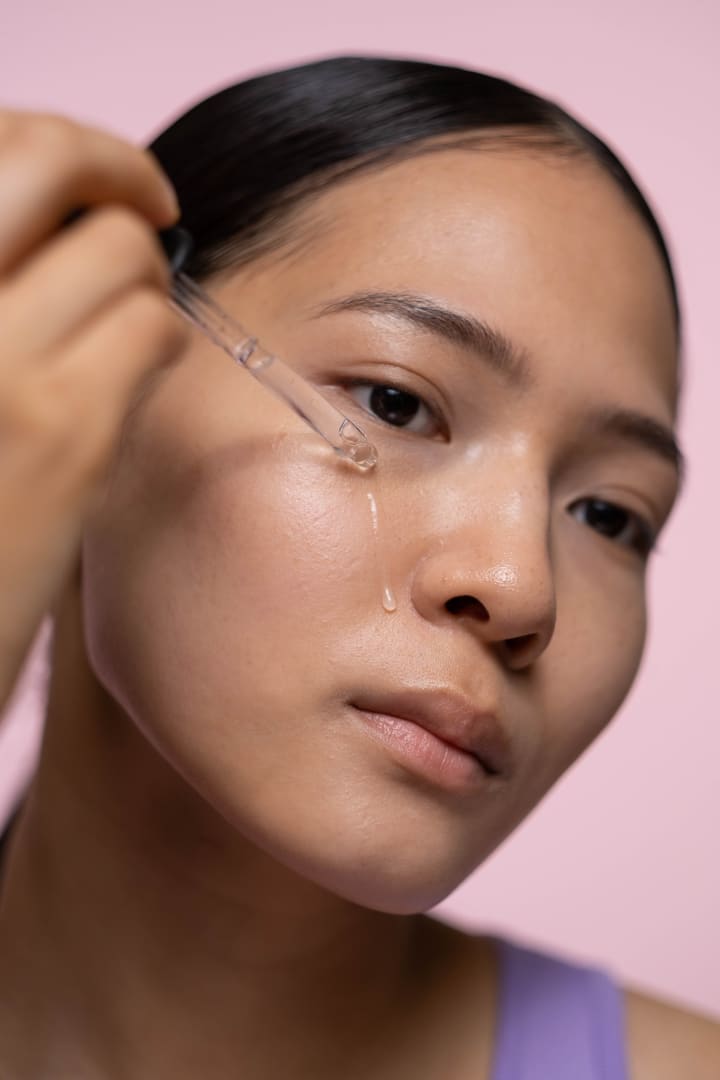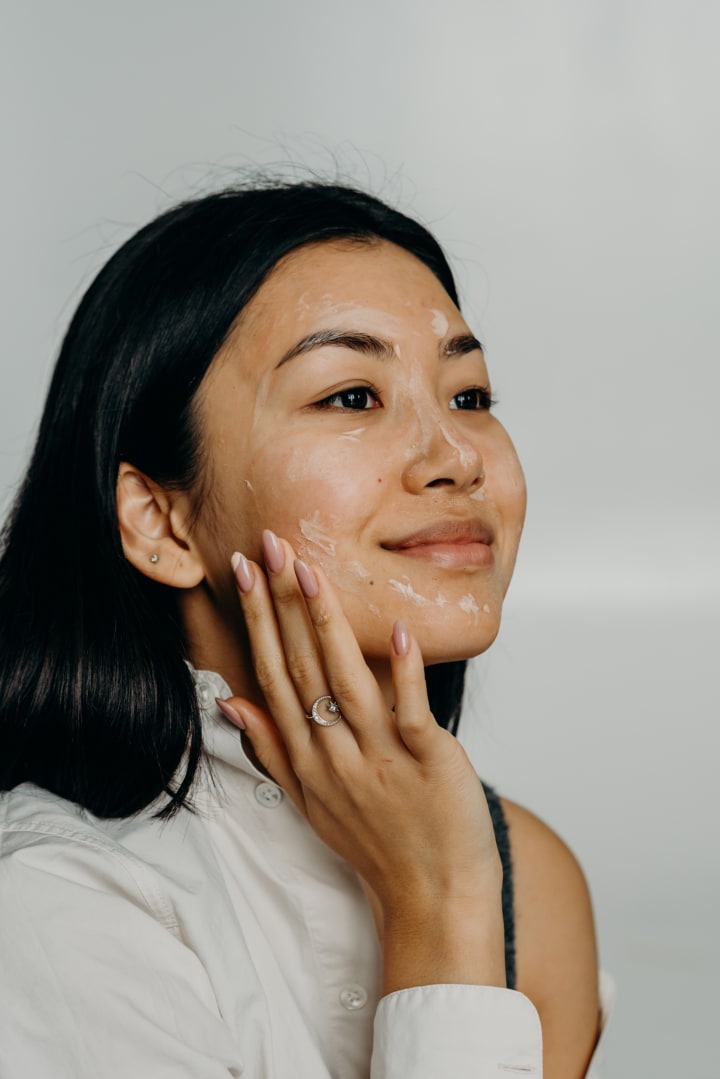The Basics Of Face skin Care.A Guide To Healthy And Glowing Skin
skin care

When we try to look good and take care of ourselves, our faces often get the most attention. Our faces show how we feel, what we’ve been through, and who we are. It’s no surprise that we all want healthy, beautiful skin that looks bright and full of life.
The basics of face skin care are important steps that lay the groundwork for getting and keeping that healthy, glowing appearance that everyone wants. Whether you’re a skincare expert or just starting to learn about face care, it’s important to know these basics if you want to bring out the natural beauty of your skin.
This full guide is meant to give you all the information and tools you need to start your journey towards better skin. We’ll talk about the basics of caring for your face skin, from how important it is to stick to a routine to how your food and way of life can affect your skin’s health. We will talk about the different types of skin and the most common problems. We will also give you tips and suggestions that are specific to your needs.
By the end of this guide, you will have a solid understanding of the basics of face skincare and have the information you need to make smart choices about your skincare routine. This guide will help you find your way to healthy, glowing skin, whether you want to deal with specific problems like acne, dryness, or signs of aging or just want to improve your skin’s general health and look.
So, let’s start figuring out how to unlock your skin’s full potential and see how a good face skincare routine can change your life. Get ready to start on a fun journey that will lead you to a healthy, brighter skin tone that really shows off your inner beauty.
10 TIPS ON HOW TO TAKE CARE OF YOUR FACE SKIN
1. Cleansing
Face washing is an important part of taking care of your skin. Here is a step-by-step plan for how to clean your face well,
Start by getting everything you need, like a cleanser for your skin type, cold water, a clean towel, and any other skincare products you use regularly.
If your hair is long, tie it back or put a cap on it to keep it out of your face. This will keep your hair from getting in the way of getting clean.
Makeup should be removed from the face and eyes with a makeup remover or micellar water. This can be done with a cotton pad or another soft material.
Soak your face in tepid water to soothe your skin. Avoid using extremely hot water, since this can remove your skin’s protective oils, leaving your skin dry and irritated.
Use your fingertips to apply a tiny amount of your facial cleanser. Use circular motions to gently massage the cleanser into your moist face. Look closely at your eyes, lips, nose, and chin. Scrubbing too roughly might cause skin irritation, so take care.
For the next minute, keep kneading the cleaner into your skin. In this way, the cleanser can penetrate your pores and thoroughly remove grime, extra oil, and other impurities.
Make sure all the cleanser is gone by rinsing your face with lukewarm water. Remove any lingering residue from your skin.
Dry your face with a clean towel by patting it lightly. To prevent friction and discomfort, the towel should not be rubbed against the skin.

2.Moisturize
Face moisturizer is an important part of any skin care practice. Here is a step-by-step guide on how to moisturize your face,
Start by washing your face with a gentle cleaner made for your skin type. Use water that isn’t too hot or too cold. Hot water can remove natural oils.
Use a clean towel to pat your face dry. Don’t rub or scrub your skin, because it can irritate it.
Choose a moisturiser that is right for your face. If your skin is dry, choose a moisturiser with a cream base. Choose a light, oil-free moisturiser if you have oily or mixed skin. If your skin is sensitive, look for items that say they are hypoallergenic or have no scent.
Put a little bit of moisturiser on your fingers. You can change how much you use based on what your skin needs, but a pea-sized amount should be enough for the whole face.
Use gentle, upward strokes to put the moisturiser on your face. Begin in the middle of your face and move outward. Make sure your whole face is covered, including your forehead, cheeks, nose, and chin. Try not to put the moisturiser too close to the sensitive area around your eyes.
Apply moisturiser to your neck and chest as well, since these areas are often subject to the same things as your face.
Use your fingers to gently rub the moisturiser into your skin in small circles. This helps the blood flow and makes sure the product is spread out evenly.
Before you put on makeup or sunscreen, give the moisturizer a few minutes to soak into your face. This makes the product work well and gives other goods a smooth place to go.
3. Sun Protection
Facial sun protection is crucial for keeping skin healthy and free of sun damage. Here is a detailed explanation on how to shield your face from the sun.
Apply a broad-spectrum sunscreen with an SPF of 30 or higher on your face as a first step. Select a sunscreen that blocks both UVA and UVB rays. Spread it liberally throughout your entire exposed face, including your eyes, mouth, and nose. Make sure your ears are hidden as well as the rest of your face.
a cap with an expansive brim for protection from the sun’s rays. If you want complete shade from the sun, you should get a hat with a brim that is at least 3 inches (7.6 cm) in circumference. Choose hats crafted from tightly woven fabrics for maximum defence against the sun’s rays.
Wearing sunglasses that block out 100% of UV rays is a must to protect your eyes and the skin surrounding them. Sunglasses should block both UVA and UVB rays, so look for that designation. This will aid in avoiding cataracts and other sun-related eye problems by protecting the eyes from the sun’s harmful rays.
When the sun is at its hottest, between 10 a.m. and 4 p.m., it’s best to stay in the shade. If you must spend time in the sun, seek cover from a nearby tree, umbrella, or building. In this way, your face will be protected from the sun’s rays.
Wearing protective clothes, such as a lightweight long-sleeved shirt or blouse, can help shield your face and neck from the sun. Check the Ultraviolet Protection Factor (UPF) rating or the weave density of the garment to determine how much protection it offers from the sun’s rays.
4. Exfoliation
If you want clearer skin, cleaner pores, and a more radiant glow, exfoliating your face is a must. Follow these simple steps to exfoliate your face,
Make sure your face is clean and clear of makeup and grime before you exfoliate. Get rid of dirt and oil with a mild face cleanser designed for your skin type.
scrapes and chemical peels both work to remove dead skin cells. In contrast to chemical exfoliants, which dissolve dead skin cells by using substances like alpha hydroxy acids (AHAs) and beta hydroxy acids (BHAs), physical exfoliators use small particles or granules to physically brush away dead skin. Find an exfoliant that works with your skin’s sensitivity by reading the labels. Read more on exfoliation here.
Use warm water to splash your face or a damp towel to wet your skin. This will help your pores open up and make cleansing work better.
Take a small amount of the scrub and put it on your face softly. Start in the middle of your face and move towards the edges. Be careful around your eyes because that area is sensitive and needs a lighter touch.
Gently rub the exfoliator into your skin in circular motions with your fingers. Don’t put too much pressure on your skin to keep it from getting irritated or hurt.
If you have blackheads or dry places that bother you, take a little more time to gently exfoliate those spots. Be careful not to exfoliate too much, as that can cause discomfort.
Once you have scrubbed your whole face well, rinse the scrub off with cold water. Make sure that there are no signs of the product left.
Use a clean towel to pat your face dry. After that, use a moisturizer that will rehydrate and nourish your face. To keep a healthy skin layer, you must moisturize after exfoliating.
5. Hydration
Keeping your face well-hydrated is essential for radiant skin. How to hydrate your face the right way is explained in detail below.
Get rid of any grime, oil, or leftover makeup by washing your face with a mild cleanser. If you want to keep your skin’s natural oils, it’s best to wash in lukewarm water rather than hot.
Skin’s pH can be restored and made more receptive to moisture by toning. Do not get any in your eyes if you decide to use a toner; instead, put a small quantity on a cotton pad and wipe your face gently.
Serums are extremely potent cosmetics that penetrate the skin deeply and deposit their beneficial elements there. Apply a few drops of a moisturizing serum designed for your skin type to your fingertips. Apply the serum all over your face, paying special attention to the dry and parched spots. Read more here.
The skin surrounding your eyes is extremely sensitive and easily dries up. Avoid getting the cream in your eyes by putting a small quantity on your ring finger and tapping it softly around your orbital bone. This process aids in keeping the skin around the eyes supple and hydrated.
Add a moisturizing face mask to your weekly routine once or twice. Apply the mask to freshly cleansed, dried skin as directed by the manufacturer. After the allotted amount of time has passed, remove it with warm water.

6. Healthy Diet
Eating well can help your skin look and feel better in many ways, including health and vitality. The following is a list of foods that have been shown to promote good skin. Read more here on healthy diet.
Rich in omega-3 fatty acids, which help nourish the skin and reduce inflammation, fish like salmon, mackerel, and sardines are a great addition to any diet.
Avocados, which are rich in both good fats and vitamin E, can help the skin by keeping it moist and shielding it from oxidative damage.
Beta-carotene, a form of vitamin A, is abundant in sweet potatoes and may contribute to a healthy glow.
Essential fatty acids, vitamin E, and antioxidants are found in nuts and seeds including almonds, walnuts, sunflower seeds, and flaxseeds, and help keep skin supple and prevent it from drying out.
Leafy green vegetables like spinach and kale have been shown to have positive effects on skin health due to their high vitamin, mineral, and antioxidant content.
Vitamin C, which is abundant in citrus fruits like oranges, lemons, and grapefruits, helps the body make collagen, which in turn makes the skin more firm and less prone to wrinkles.
7. Avoid Touching Your Face
The repercussions of touching your face, both good and bad, are complex. Some frequent side effects of facial touch are listed below.
The bacteria and germs on our hands increase throughout the day as we touch various surfaces. Microbes on your hands can be transferred to your face when you touch your face, raising your risk of developing a skin infection, a cold, or something far more serious.
The skin on your face might become irritated and break out if you touch it too often. Acne and other skin diseases like rosacea and eczema can be made worse by the dirt, oils, and bacteria that are already on your hands.
Contact with infected surfaces is a major route of transmission for several viruses, including the common cold, influenza, and Covid-19. The risk of contracting an illness after coming into contact with a virus is increased if, afterward, you touch your face.
One of the worst things you can do if you have allergies is touch your face. Pollen and pet dander are just two examples of allergens that can cling to your hands and then be transferred to your face, where they can cause an allergic reaction.
8. Avoid Harsh Products
The face is especially vulnerable to damage from a wide variety of potentially dangerous products. Some instances are as follows,
Some facial cleansers, like sulphates, alcohol, and scents, can be too irritating to the sensitive skin on the face. These tend to be very drying and can cause irritation and breakouts by removing the skin’s natural oils.
Moisturisers are necessary for healthy skin, but people with oily or acne-prone skin should avoid using products that are too thick or greasy because they can clog pores and lead to outbreaks.
Some people experience irritation from the fragrances added to their skincare products, such as face cleansers, toners, and lotions.
Scrubbing your face with a brush that has rough or jagged bristles can cause tiny rips in your skin, which can then become inflamed, irritated, and even infected.
9. Makeup Removal
Taking off your makeup at the end of the day is a must for clean skin. Taking it off has these three advantages
Makeup removal is important because it lets skin breathe and stops pores from getting blocked, both of which can lead to skin problems including acne, breakouts, and blackheads. Makeup, especially foundation and other thick cosmetics, can trap oil, debris, and bacteria on the skin and exacerbate existing conditions. Taking off your makeup at the end of the day aids in keeping your skin fresh and clear.
The skin naturally repairs itself and rejuvenates while you sleep. Makeup removal before bedtime aids the skin’s natural regeneration process. Leaving makeup on overnight can prevent the skin from renewing itself, leading to a more weary and drab appearance in the morning. Makeup removal promotes skin renewal, which helps skin retain its healthy glow.
Makeup, especially that which contains strong chemicals, might hasten the ageing process of your skin. Damage to collagen and elastin fibers—responsible for the skin’s suppleness and young appearance—can result from the usage of these products due to dryness, inflammation, and oxidative stress. Taking the time to remove your makeup and wash your face each night will help you avoid the negative effects of these chemicals and keep your skin looking fresh and young.
10.Stress Management
It’s possible that some people are more vulnerable to the facial consequences of stress than others.
Acne and other skin disorders may become more severe under stress. Hormones like cortisol, which are released in response to stress, have been linked to increased sebum production. Acne is caused by the blockage of pores by oil, dead skin cells, and bacteria that builds up over time.
Signs of facial aging can appear earlier than they otherwise would if the aging process is sped up by chronic stress. The firmness and suppleness of the skin are maintained by collagen and elastin, but stress hormones like cortisol can break them down. This can lead to premature aging signs like dullness, sagging, and the appearance of fine lines and wrinkles.
The protective barrier of the skin can be compromised by stress, making it more vulnerable to damage and discomfort. This can cause your skin to become inflamed, dry, and itchy, and potentially develop eczema or dermatitis. The effects of stress on preexisting skin issues can be particularly frustrating.
About the Creator
Abby blasius
I am a passionate content creator with a strong focus on health and wellness. While my educational background lies in a Bachelor of Accounting and Finance, it is my innate desire to help people feel good about themselves in mind, body&soul






Comments
There are no comments for this story
Be the first to respond and start the conversation.